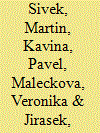| Srl | Item |
| 1 |
ID:
112329


|
|
|
|
|
| Publication |
2012.
|
| Summary/Abstract |
In 2010, the Czech Republic was one of the states of the European Union, which met the indicative target for the share of renewable energy sources in gross electricity consumption. That year, gross electricity generation from renewable sources amounted to a total volume of 5851 GWh, which corresponds to 8.24% of gross electricity consumption in the Czech Republic in the given time period. The largest share of the total came from hydroelectric power plants (47.7%) and biomass power plants (25.8%), and a smaller share from photovoltaic power plants (10.5%), biogas power plants (8.7%) and wind farms (5.7%). Compared with 2009, the highest year-on-year growth came from photovoltaic power plants (527 GWh, 44.2%) and, as far as other renewable sources are concerned, electricity generation at hydroelectric power plants (360 GWh, 30.2%) and biogas power plants (184 GWh, 15.4%) rose more sharply as well.
|
|
|
|
|
|
|
|
|
|
|
|
|
|
|
|
| 2 |
ID:
115163


|
|
|
|
|
| Publication |
2012.
|
| Summary/Abstract |
The Czech Republic is the world's sixth largest exporter of electricity. It currently faces a fundamental decision on a new orientation of its energy strategy. Current electricity generation is based on coal (54.7%) and nuclear energy (32.7%). Nowadays the lifespan of the recoverabe reserves is less than 20 years in case of sub-bituminous coal and less than 2 years in case of uranium. Also the original lifespan of all 4 blocks of the power station Dukovany, one of county's two nuclear power plants, is approaching. These are the main reason why the Czech Republic is forced to revise its future energy strategy as well as its current optimal energy mix. This paper analyses the role of individual energy minerals in the future electricity generation portfolio of the Czech Republic. From the point of the energy security, it seems to be optimal to increase the availability of domestic sub-bituminous coal and continue with the preparation of new nuclear energy blocks and extending the lifespan of existing ones. These actions should be supported by investments to the geological survey of domestic uranium deposits. Impartial evaluation of RES potential and impact of their use on the electricity price is advisable simultaneously.
|
|
|
|
|
|
|
|
|
|
|
|
|
|
|
|